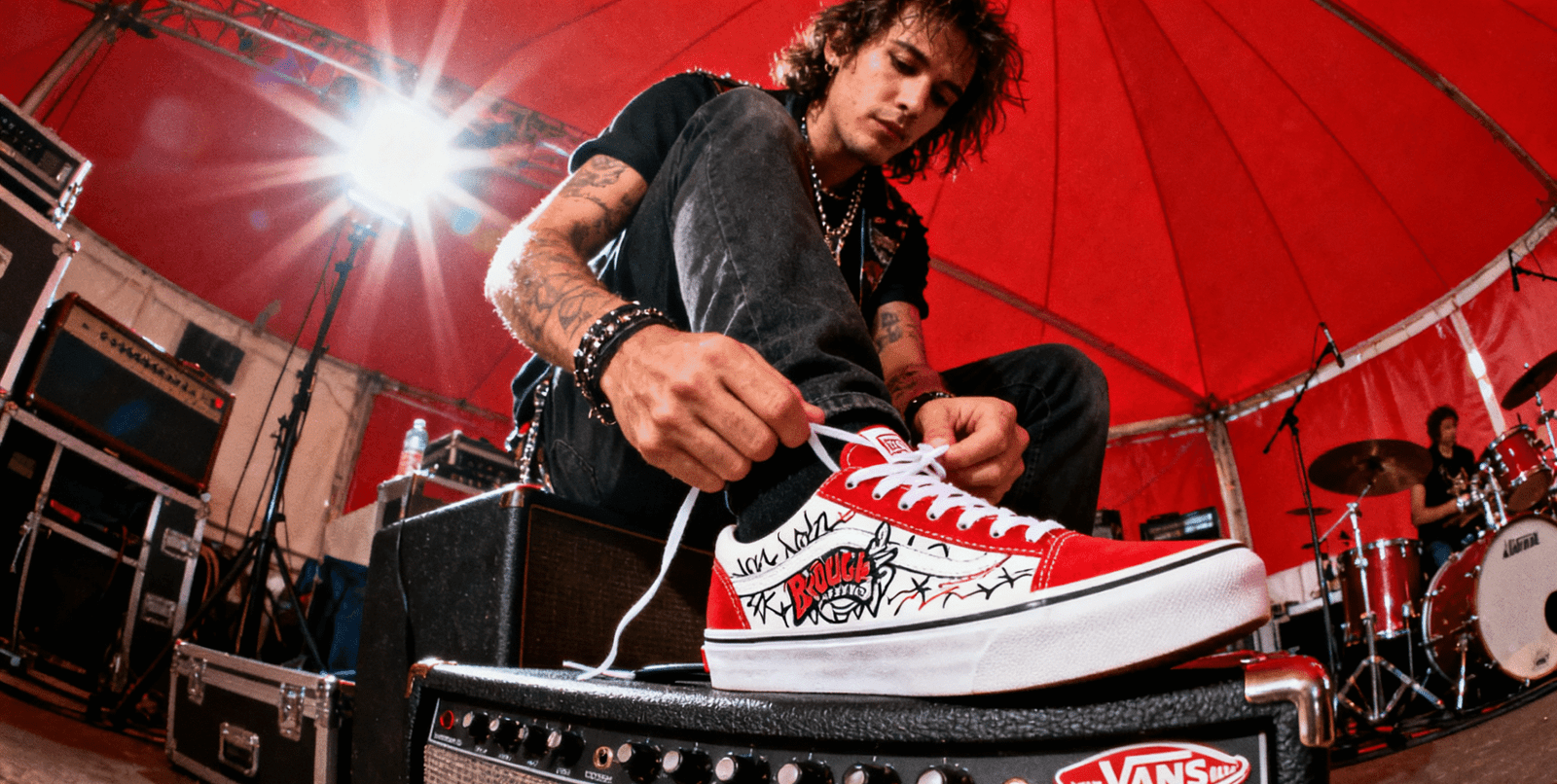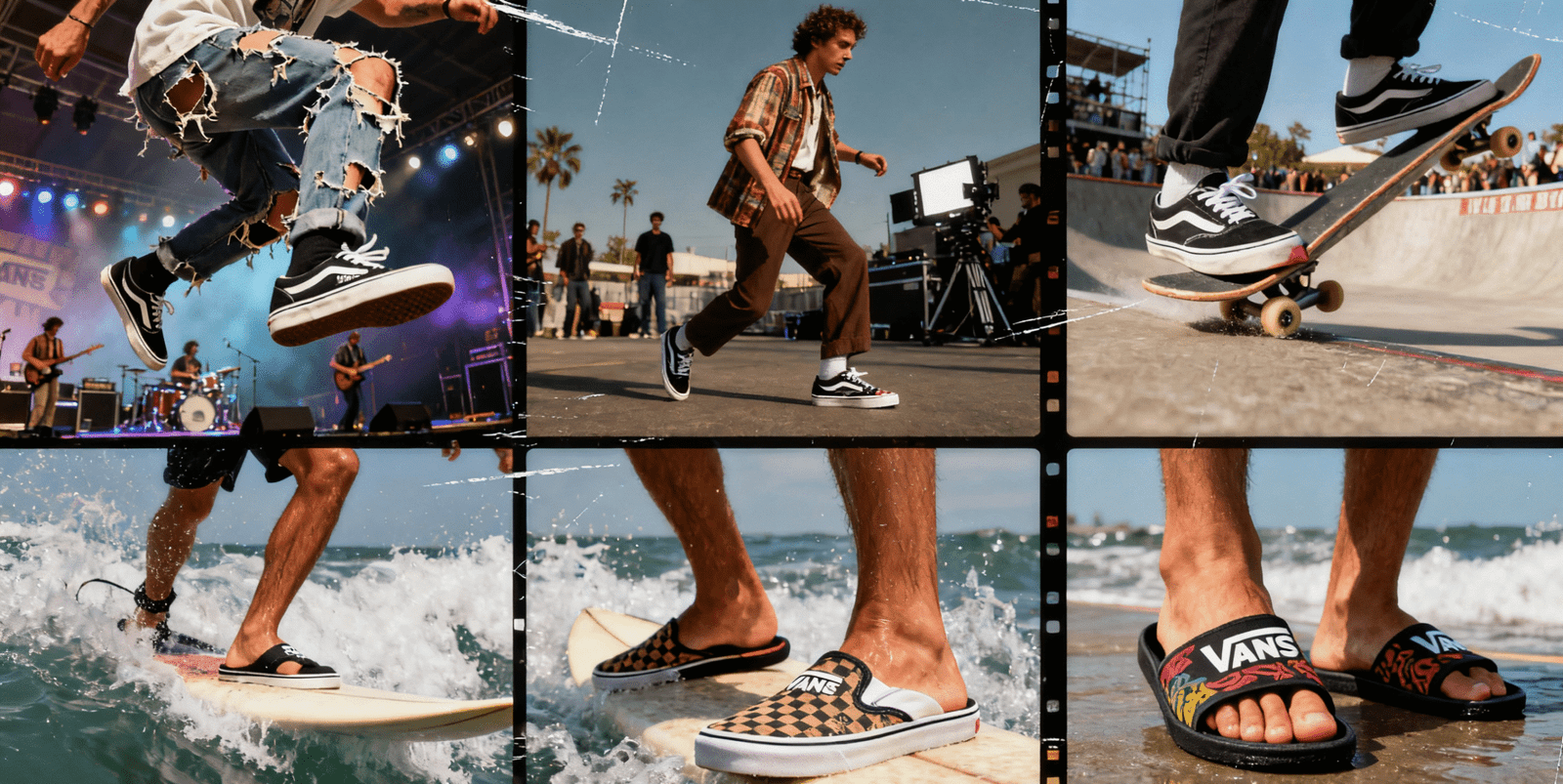Problem: You know Vans for their iconic waffle soles and California skate culture roots. Agitation: But how did a shoe designed for skateboarders end up gracing high fashion runways and becoming a global style staple, far beyond the skate park? Solution: Let's explore the strategic moves and cultural shifts that propelled Vans from humble beginnings to a ubiquitous fashion icon.
Vans transitioned from skateboards to high fashion by organically cultivating authentic street credibility within youth subcultures, then strategically leveraging celebrity endorsements, high-profile fashion collaborations, and a timeless design aesthetic that resonated with a broader audience seeking a blend of laid-back cool and understated versatility, making them a fixture in both casual and elevated wardrobes.

In my 25 years in the shoe manufacturing industry, I've seen countless brands rise and fall. Few have managed to maintain their authenticity while simultaneously breaking into the mainstream and even high fashion, quite like Vans. Their journey is a masterclass in brand building, proving that true style often emerges from genuine culture.
How Did Vans Transition from Skateboards to High Fashion Runways? Problem: It seems improbable that a shoe born on gritty skate ramps could end up alongside designer apparel. Agitation: How did Vans bridge the gap between niche subculture and mainstream fashion, let alone reach high fashion status? Solution: Let's uncover the key strategies and organic movements that propelled Vans onto the runways.
Vans transitioned from skateboards to high fashion runways through an organic yet strategic process involving deep cultural roots, subtle celebrity adoption, and eventually, high-profile collaborations with luxury brands. Their timeless designs, which exuded an effortless cool gained from their authentic connection to skate and surf culture, became appealing to designers seeking to infuse street credibility and a relaxed aesthetic into their collections.

At Lucas, while we're manufacturing for diverse footwear needs, we always analyze successful brands. Vans' journey is particularly insightful. They didn't chase high fashion directly. Instead, they built an undeniable foundation of cool that high fashion eventually came to them for.
What was Vans' organic rise from subculture?
Vans started by serving a specific need.
- Skateboarding Roots: Paul Van Doren started Vans in 1966. He made shoes specifically for skateboarders. The sticky waffle sole gave amazing grip. This was crucial for board control. Skaters adopted them. This gave Vans instant street cred.
- Authenticity: Vans didn't market to skaters. They were the skaters. They listened to their needs. This created a loyal following. It was genuine. This authenticity is a powerful magnet. It attracted those looking for something real.
- Customer Customization: From early on, Vans offered custom shoe options. Skaters could pick their colors and patterns. This fostered a deep connection to the brand. It also pioneered personalization.
This organic growth built a foundation of genuine cool. It was not manufactured. This is a very rare and valuable asset for a brand.
How did celebrity and film influence their growth?
- Sean Penn in "Fast Times at Ridgemont High" (1982): This was a pivotal moment. Jeff Spicoli, played by Sean Penn, wore checkerboard slip-ons. This instantly catapulted Vans onto a national stage. It showed the shoes outside skate parks. They became a symbol of California cool and rebellious youth. This exposure was huge. It introduced Vans to a much wider audience beyond subcultures.
- Music Scene Adoption: Punk rockers, new wavers, and musicians started wearing Vans. This gave the brand an edgy, counter-culture appeal. Their simple, customizable canvas served as a blank slate for individual expression.
- Subtle Celebrity Endorsement: Over the years, many celebrities were seen wearing Vans casually. This wasn't always paid. It was natural. This made the brand seem effortlessly cool.
What role did fashion collaborations play?
As Vans' street credibility grew, high fashion noticed.
- Early Designer Interest: Designers started using Vans in their shows. They styled them with high-end apparel. This was often unprompted. They recognized the shoes' cool factor.
- Strategic Collaborations: Eventually, Vans started official collaborations.
- Marc Jacobs: Early collaborations with Marc Jacobs' diffusion line elevated Vans. They combined high-end design with Vans' iconic silhouettes.
- Supreme: Ongoing collaborations with Supreme cement Vans' place in streetwear. This keeps them relevant with a crucial hype audience.
- High-Fashion Partnerships: More recently, Vans has collaborated with brands like Comme des Garçons and Our Legacy. These partnerships place Vans directly in the luxury fashion conversation. They show the shoes' versatility. They prove that Vans can be both humble and high-end.
These collaborations allowed Vans to maintain their core identity. They also expanded into new markets. It was a careful balance. They never lost sight of their heritage.
What Collaborations Helped Vans Gain Global Popularity? Problem: Vans is a household name now, but it wasn't always this widely recognized. Agitation: It's hard to pinpoint exactly how they went from regional skate shoes to a global phenomenon. Solution: Let's examine the key collaborations that amplified Vans' reach and solidified its worldwide popularity.
Vans gained global popularity through a series of strategic collaborations across diverse cultural realms: from pivotal fashion partnerships with designers like Marc Jacobs and high-end streetwear brands such as Supreme, to impactful artistic ventures and, crucially, consistent visibility within music, film, and extreme sports communities. These collaborations broadened their appeal beyond skate culture, cementing their status as a versatile and universally cool footwear brand.
What pivotal fashion collaborations were there?
- Marc Jacobs (2000s): This was a game-changer. Marc Jacobs, a respected high fashion designer, created special Vans models. This elevated Vans' perception. It showed them that they could be desirable beyond their core market. It brought an air of luxury to the casual shoe.
- Supreme: The ongoing partnership with Supreme is iconic. Supreme is a pillar of global streetwear. Collaborations with them generate immense hype. They sell out instantly. This keeps Vans at the forefront of street culture. It ensures their continued relevance with a trendsetting audience.
- Concepts, WTAPS, Anti Social Social Club: These collaborations tap into specific streetwear and lifestyle segments. They create limited-edition drops. This feeds the collector's market. It amplifies desirability.
- High-End Brands (e.g., Comme des Garçons, Our Legacy): These collaborations truly bridge the gap to high fashion. They place Vans in luxury boutiques. They show designers interpreting Vans' classic styles. This solidifies their fashion bona fides.
How did artistic and cultural collaborations play a role?
Vans has a rich history of celebrating creativity.
- Artists and Designers: Vans has collaborated with various artists. This includes Takashi Murakami, Kenzo, and others. These partnerships bring fresh perspectives to classic Vans patterns. They also introduce Vans to art enthusiasts.
- Music Labels and Bands: Vans' connection to the music scene is deep. Collaborations with bands (e.g., Metallica, Iron Maiden) and music labels (e.g., Warner Bros.) create shoes that resonate with fan bases. This extends their reach into music subcultures.
- Disney, Marvel, Peanuts: These popular culture collaborations appeal to a mass market. They tap into nostalgia. They attract families and collectors. This broadens Vans' demographic appeal significantly.
| Collaboration Category | Example Collaborators | Impact on Vans |
|---|---|---|
| High Fashion | Marc Jacobs, Comme des Garçons | Elevated brand perception, entry into luxury markets |
| Streetwear Hype | Supreme, Concepts, WTAPS | Maintained street credibility, generated immense buzz |
| Artists/Designers | Takashi Murakami, Kenzo | Infused creative artistry, attracted art collectors |
| Music Culture | Metallica, A Tribe Called Quest | Deepened roots in music, appealed to band fans |
| Pop Culture Icons | Disney, Marvel, Peanuts | Expanded mass market appeal, tapped into nostalgia |
| Skate/Sportswear | Thrasher, Independent Trucks | Reinforced core id |
